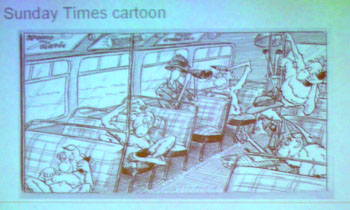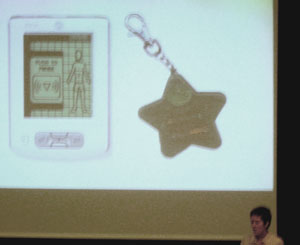We've now moved on to the next keynote, by Nina Wakeford from INCITE at the University of Surrey; I saw her keynote at ISEA2004, of course, but I think this one is on a different topic. I also just ran in to fibreculture's own David Teh - good to see another familiar face!
Nina considers how we might think about ubiquity - through developments of ubicomp, and through analogous social and cultural activities; also, how might we intervene in already existing ubiquity work? A guiding example is the 'gaydar', a new technology for gay men to find one another through mobile devices. What exactly is it that ubiquitous computing promises, what technologies may it replace?
British Telecom has started to replace its traditional phone boxes with Internet kiosks, for example, but few people have used them for such activities so far; warchalking became a bit of a trend and a clear symbol for ubiquity, but how significant is it reall? Nina's Urban Mobilities Project with Intel focussed on an understanding of how the consumption of digital information is related to experiences of place, agency, and the digital divide; how are places 'consumed' alongside technological devices and services?
Perhaps here it is more useful to think of 'mobility' rather than 'ubiquity'. A key approach in this was to begin with heterogeneity and seek out diverse populations - this is the idea of inconvenience sampling (the choice of difficult rather than homogeneous focus groups) which she also talked about at ISEA.
 A Newspaper Cartoon about Nina's Anthropological WorkThe project, then, started by using the 73 bus route in central London which traverses a number of very diverse local areas. What, to start with, is the experience of 'bus culture' in London? How is it inflected by the bus as a piece of mobile technology? How are bus stops embedded into localities and what is the experience they provide; what are the Internet spaces along the route and how are they linked through the connection of the bus line?
A Newspaper Cartoon about Nina's Anthropological WorkThe project, then, started by using the 73 bus route in central London which traverses a number of very diverse local areas. What, to start with, is the experience of 'bus culture' in London? How is it inflected by the bus as a piece of mobile technology? How are bus stops embedded into localities and what is the experience they provide; what are the Internet spaces along the route and how are they linked through the connection of the bus line?
This leads to a disaggregating of public spaces: not all public spaces are equally 'public'; Internet cafes are themselves mobile devices where users use them in the same way they would a mobile phone; bus routes are not necessarily continuous; and there is a way in which blogging might be a way of consuming (writing) the city which research associated with this project also came across.
In the catchcry of 'must blog this', blogging became a mode of perception or sensibility for the city - a kind of blogging antenna. How do we then intervene in discourses of ubiquity, based on such data? Interdisciplinary design workshops, an experimental bus blog, and other media interventions played a part here. In design workshops, the project developed some devices and media forms as a response - including the 73urbanjourneys.com Website, which gave the bus itself a blog.
The intention was to also use this site as a data collection tool; it allows people to add their own stories which are attached to seats on the bus. Also, could the blog incorporate things which were lost, left, or found on the bus itself, as a way of reconceptualising ubiquitous mobile devices? In the computer science arena, ubiquitous computing arose in the late 1980s, as a third wave of computing after mainframes and personal computers.
Intel Research has been pushing the idea of proactive computing, which moves away from interactive computing which increasingly overloads humans with a need to interact and respond to computer requests; proactive computing preemptively senses user's needs to make their interaction with technology easier and more intuitive. There are various projects working towards these aims.
One example which Nina has been involved is is Familiar Stranger (developed at Intel), which is aiming to spot people whom we regularly encounter in spaces we frequent (but whom we don't know). Is this desirable, though? This could be done through dedicated technology or mobile phones. Nina suggests that this is much like the idea of the gaydar - a system to spot other gay men who carry the same device. Lessons can be learned from the queer movement here - there is movement and migration to 'find yourself', mobility practices are used to experiment with ways of being, and there is an 'identity quest experience' which is played out in everyday movement.
Also, there is a long history of queer Internet use. The Internet has a capacity to contain queer and other heteronormative experiences, in a variety of communication technologies (Usenet, MUDs and MOOs, mailing-lists, Websites, community and commercial portals, and blogs); interestingly, also, a lot of the blogs that the 73 bus route project found were blogs by gay men - perhaps, Nina suggests, a result of the improvement in HIV/AIDS treatment which enables positive gay men to write their own histories again without the constant reminder of mortality.
 The Gaydar in Various GuisesBack to the gaydar, then: the 'Gaydar Deluxe 2.2a' is a tongue-in-cheek technology available for the PalmPilot, and there are also other key chain-style devices which are meant to fulfil the same function. Nina suggests that such devices recognise the battles (personal and political) over intimacy in the public sphere. The pathways, vectors and flows themselves of ubiquity may be as important as the places and spaces which they connect.
The Gaydar in Various GuisesBack to the gaydar, then: the 'Gaydar Deluxe 2.2a' is a tongue-in-cheek technology available for the PalmPilot, and there are also other key chain-style devices which are meant to fulfil the same function. Nina suggests that such devices recognise the battles (personal and political) over intimacy in the public sphere. The pathways, vectors and flows themselves of ubiquity may be as important as the places and spaces which they connect.
Finally, then, Nina talks about intervening in technology design. She stresses the value of interprofessional hyperlinks between discourses, and of recognising and using 'boundary objects' between social and professional spaces.












